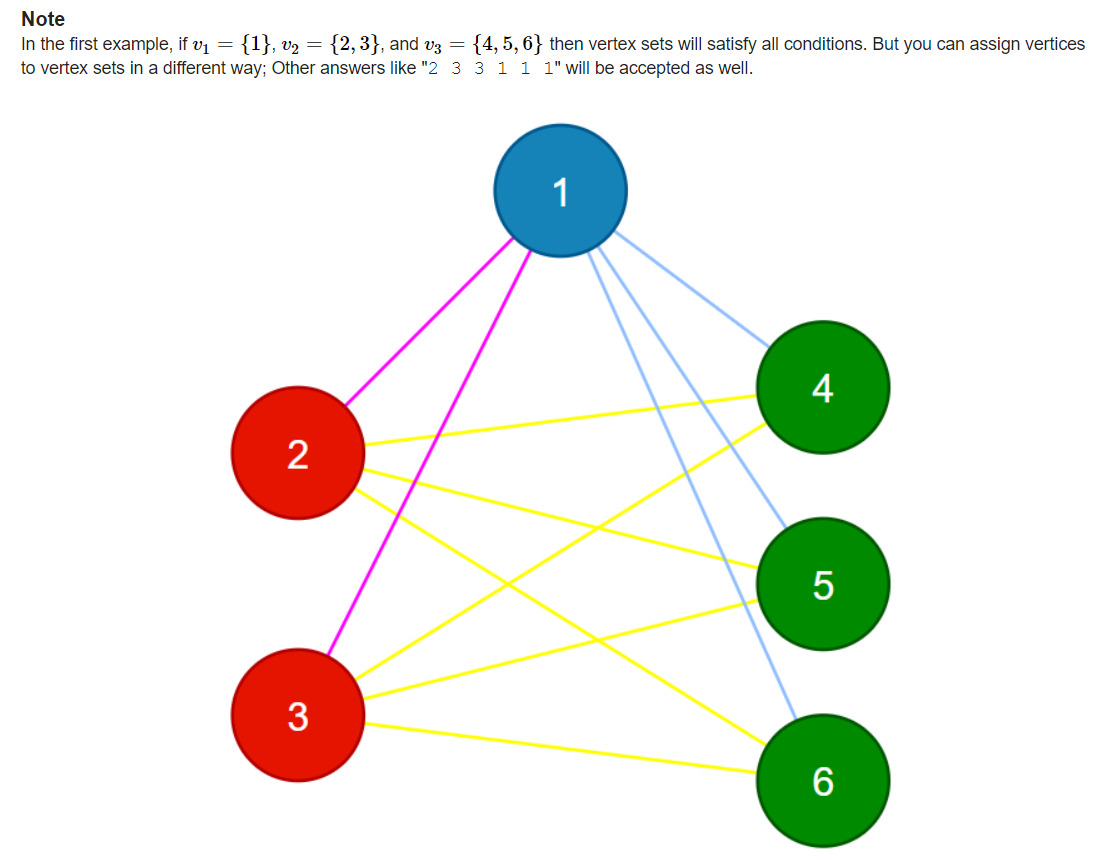

input
6 11
1 2
1 3
1 4
1 5
1 6
2 4
2 5
2 6
3 4
3 5
3 6
output
1 2 2 3 3 3
input
4 6
1 2
1 3
1 4
2 3
2 4
3 4
output
-1

题意
在一张无向图(无自环,不一定联通)中,将所有节点划分为三个集合,每个集合内部的任意
两个点不可以有边,集合件任意两个点必须有边,求出如何划分集合
思路
对于整张图来说:
第一我们需要满足一共只划分三个集合,所以当集合数量超过3时我们就可以确定无解
第二对于一个节点x,未与x相连的所有节点的子节点必须与x相连
代码
#pragma GCC optimize(2)
#include<unordered_map>
#include<algorithm>
#include<iostream>
#include<cstring>
#include<cstdio>
#include<string>
#include<vector>
#include<queue>
#include<stack>
#include<cmath>
#include<map>
#include<set>
#define Buff ios::sync_with_stdio(false); cin.tie(0); cout.tie(0);
#define rush() int Case = 0; int T; scanf("%d", &T); while(T--)
#define rep(i, a, b) for(int i = a; i <= b; i ++)
#define per(i, a, b) for(int i = a; i >= b; i --)
#define reps(i, a, b) for(int i = a; b; i ++)
#define clc(a, b) memset(a, b, sizeof(a))
#define readl(a) scanf("%lld", &a)
#define readd(a) scanf("%lf", &a)
#define readc(a) scanf("%c", &a)
#define reads(a) scanf("%s", a)
#define read(a) scanf("%d", &a)
#define lowbit(n) (n&(-n))
#define pb push_back
#define sqr(x) x*x
#define rs x<<1|1
#define y second
#define ls x<<1
#define x first
using namespace std;
typedef long long ll;
typedef unsigned long long ull;
typedef pair<int, int>PII;
const int mod = 1e9+7;
const double eps = 1e-6;
const int N = 1e6+7;
int idx, h[N], e[N<<1], ne[N<<1];
int color[N], vis[N], clo;
int n, m;
void add(int a, int b)
{
e[idx] = b, ne[idx] = h[a], h[a] = idx ++;
}
bool judge(int x)
{
// cout << n <<" "<< m <<endl;
if(clo == 4) return false;
color[x] = ++clo;
int t = 0;
for(int i = h[x]; ~i; i = ne[i])
{
int j = e[i];
// cout << j <<" ";
vis[j] = true; t ++;
}
// cout << "t: " << t <<endl;
rep(i, 1, n)
{
if(vis[i] || i == x ) continue;
int c = 0;
color[i] = clo;
for(int j = h[i]; ~j; j = ne[j])
{
int p = e[j];
if(!vis[p]) return false;
c ++;
}
// cout << c <<" "<< t <<endl;
if(c != t) return false;
}
clc(vis, 0);
return true;
}
int main()
{
Buff;
clc(h, -1);
cin >> n >> m;
rep(i, 0, m-1)
{
int a, b;
cin >> a >> b;
add(a, b);
add(b, a);
}
for(int i = 1; i <= n; i ++)
if(!color[i] && !judge(i)) return puts("-1");
if(clo != 3) return puts("-1");
rep(i, 1, n) cout << color[i] << (i == n ? "
" : " ");
return 0;
}